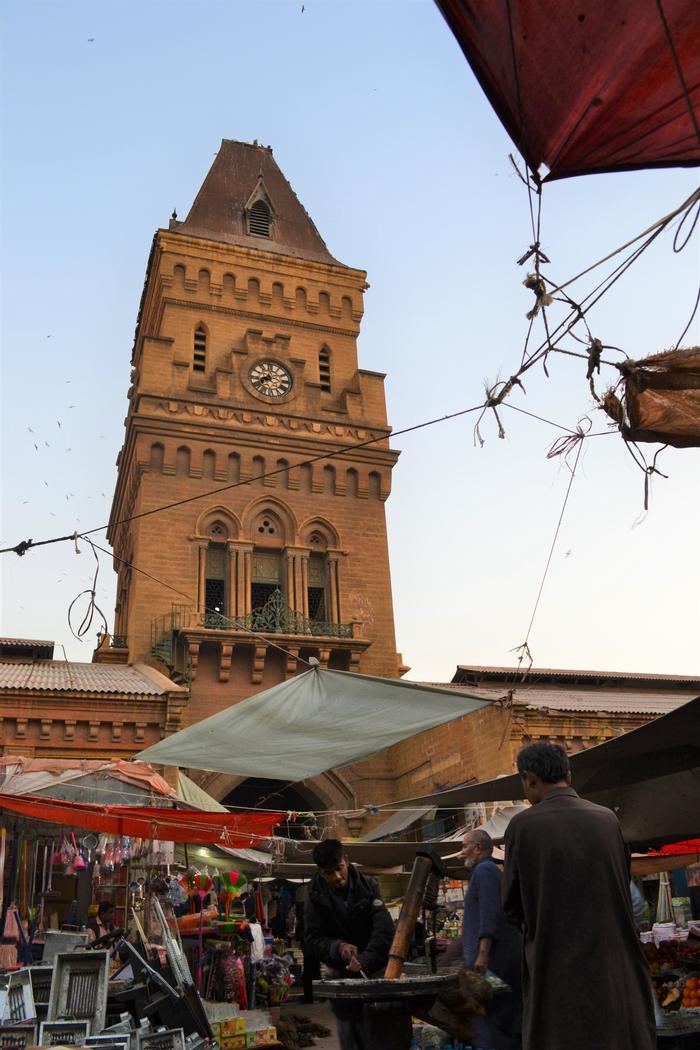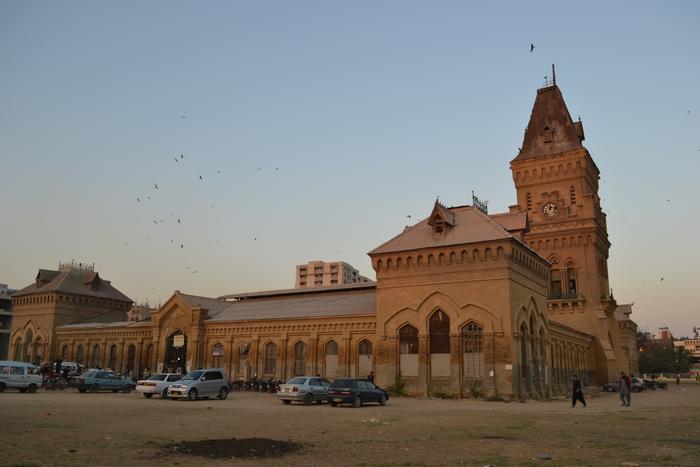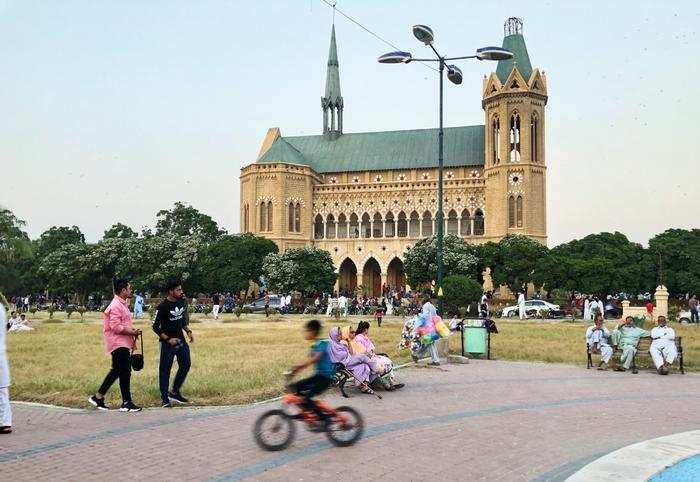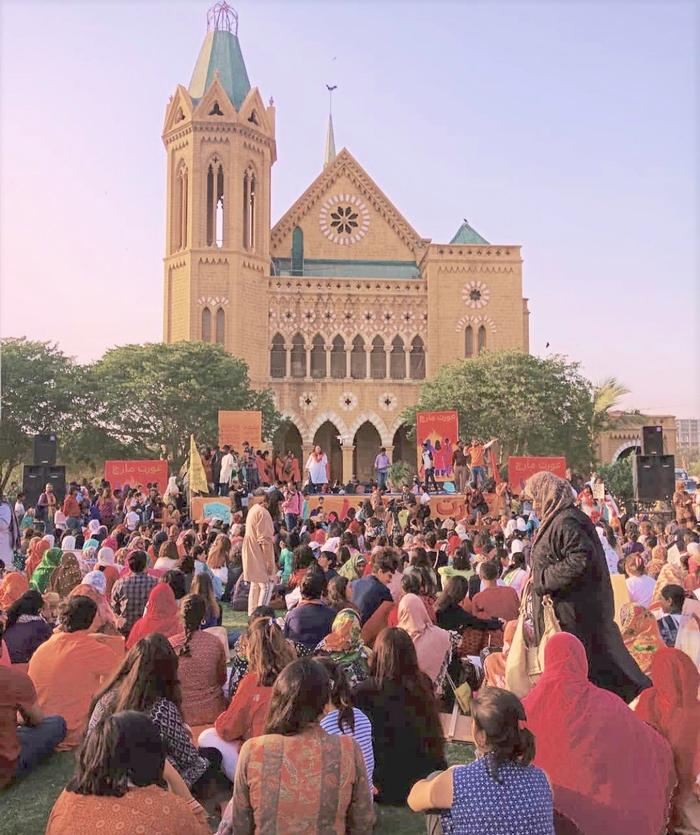[ID:3796] Subversion in the Colonial Public: How indigenous people reconfigure infrastructure to create democratic civic spaces in KarachiPakistan Two strangers decided to collaborate on this project, simply because both are interested in uncovering facets of life that make this otherwise unlivable city worthwhile. We believe that the understanding of social change and practice coupled with knowledge of space and design would prove valuable in uncovering and quantifying the physical elements that create intangible relationships and become the driving force behind communities.
The existence and future of civic spaces in Karachi hangs precariously over everyday life. Karachi and its civic spaces have undergone immense turmoil and change. Factors such as terrorism, romantic notions of ‘development’, gentrification and neo-liberalism have acted upon its body and are still actively working and changing the distinct characteristics of this multi-class, multi-cultural city. Through this process one notices the disappearance of people, and the appearance of security in public life. This manifests physically, not only in the police and ranger details, one spots on the way to work or school but also in hostile physical boundaries such as fences, walls and barriers. It is significant to note the type of bodies that are otherized and excluded, it is often the working-class male and female that are denied access to the commons. The luxury of public space and entertainment is offered either in air-conditioned environments such as shopping malls where the presence of the male working class is heavily monitored and siphoned out. Other examples of these spaces are gated parks, clubs and food/culture festivals that are rendered inaccessible due to ticketing and profiling. Questions of what a civic space really is, what it looks like, who is to occupy it, and perhaps the most important, who gets to decide all of these factors is determined by other forces instead of public agency. Majoritarian understandings of the public, space, and the welfare of the people stem from a legacy of coloniality and create a tenuous and fragile relationship between people and space. Colonial ideals of gentrification, progress, legality and beautification have become core concerns of the State and the ruling elite. Karachi has seen the birth and building up of a newly created Pakistan. It has seen the British come and go. It has survived Islamisation, terror attacks and is constantly negotiating and re-making itself according to culture, class and contemporary ideas of modernization and the neo-liberal. All these historic factors are at play today and are threatening the existence, character and democratic integrity of the civics. Due to the gentrified and securitized nature of the city, it is difficult to find civic spaces that are democratic, successfully drawing in, as well as sustaining social and public life the way Frere Gardens and Empress Market have. This is why it appeared inevitable that we would explore Empress Market and Frere Gardens, not only because of their central position in the physical context, history and social fabric of the city but also in part, due to the threat of extinction they face today. Now more than ever it becomes important to revisit and learn what has made them so vital in the lives of people as a lesson for the future of public space. Empress Market was first established, in 1889, on an historic parade ground where freedom fighters of the 1857 rebellion were blown from the mouths of cannons and buried there. The market was built upon their graves by the British in fear of a potential monument being erected by locals to memorialize the martyrs, thus the present bazaar was created to commemorate Queen Victoria instead. Designed to provide household goods, vegetables, fruits and meat in a palatable environment to the white populace of Karachi, the building was arranged around a courtyard with four galleries in the Indo-gothic style, accommodating 280 shops and stalls. It is located within the area of Saddar, along a major axis, which was a posh commercial hub for British officers and their families. The site of this building is significant due to its position in the city and one of the major reasons it draws the public. As part of a larger urban plan by The British Raj, it was placed on a special axis that connected it to other important axes and buildings. Due to its integral situation, Saddar became a major public transport terminal of Karachi and eventually the termination point of numerous bus and tramway routes. This drastically changed in 1947, when the British left and the demographics of Karachi came to include a much larger, multi-class and ethnically diverse population after the partition of the subcontinent. The new national identity and users brought with them new needs and changes; the Saddar area transformed. The night clubs, bars and spaces of entertainment were later shut down, under the basis of morality and the demographic changed from upper class to lower income and middle. The retail market scrambled to accommodate to the needs of this new populace, informal stalls of cloth and sticks organically sprung up overnight, filling in whatever need was unmet. Empress Market’s colonial structure too was embraced by this informal economy. The bazaar reflected indigenous ways of building, requiring minimal infrastructure due to the financial and technical constraints of its creators and prioritizing basic elements of shade, a place to display goods and at times mobility. It grew both within the colonial host structure as a parasite and outside of it, on the streets where the gathering of commuters gave hawkers the opportunity to sell. Overtime it expanded and changed like a living entity, in symbiosis to the growing population and environment that was constantly in flux as were its needs. It spilled over from both, within the building and the outer pavements of the streets and eventually met in the middle, until there was barely a boundary between bazaar and street. This spread of the bazaar beyond the boundary of the building undid the colonial buildings objective to contain and order space and what is within. Moreover, the bazaar came to mostly obscure the massive walls of the building, blurring and disregarding the boundaries it had created. It expanded to include; a dry fruit market, tea market, paan market, book market, bird market, everything one could think of could be found here. This garnered visits from collectors and customers with acquired tastes. The regulars often developed special relationships with the store owners, haggling down prices citing reasons of familiarity and expressions of loyalty to the dukaandar (store owner), such as: “for all these years, you are the only one I buy all my dry fruit from bhai, no one else, you should be giving me a discount”. The informal economy and the origin of the bazaar both contradict and undermine the order and authority of the colonial building, as well as contrast ways of usage and modes of being between the former white customers and the present-day locals. One realizes that there exists an entirely new and conflicting decorum, movement, architectural language in the same building. We found that the collaboration that occurred between the users and building, during the inception of the bazaar caused a shift and subversion in the meaning of the space. The nature of the informal was economical and therefore accessible to all, the bazaar re-wrote the ordered nature of the colonial market. Rendering it organic and interactive, what was intended to ‘civilize’ and enforce western dogma has been reclaimed and undone. Empress market has been marked and changed by the people who use it and it has changed them, both have become important stakeholders to each other. Depending on the other for survival. This kinetic and temporal bazaar within and outside, stands in stark contrast to the authoritative, heavy and monumental building. Experientially, the materially light stalls and shops surprise one when stepping inside from the heavy stone building, bringing things down from the monumental to an intimate human scale. In 2018, the spill-over bazaar thriving for more than 60 years, around the Empress market building was mercilessly demolished under the “anti-encroachment” campaign of the government. The city mayor proposed the building be protected as a heritage site, converted into a high-end dining space. These terms of: ‘heritage’, ‘encroachment’ and ‘legality’ are inundated in colonial and anti-poor sentiments. The 1,700 shops that existed here for 50 plus years should be considered a formal part of the heritage being protected, however, because the occupied land is valuable retail space, working class people have been evicted and their source of income destroyed. The colonized state feels the need to systematically eradicate and ‘civilise’ the informal and the indigenous and in turn erases our native culture and community. Bylaws and order enforced by the state are a colonial remnant which typify the poor local hawkers as encroachers and introduce legality and illegality in these otherwise democratic spaces. One wonders if it is the hawkers that encroached upon that parade ground or the British. In reality it is the state and elite forces encroaching upon local public spaces and enforcing western notions of order, formality and beauty. Beauty here is used against the poor who are seen as ugly and uncivil, the state desires to exclude, sanitize and make uniform what is colorful, complex and pluralistic.
Nasiruddin, a local stall owner, the use of ‘stall’ here is overzealous on our part as his shop is simply a table around him, which displays his wares of everyday household items such as incense sticks, knives, surma and more. Nasiruddin lamented the loss incurred through the demolitions and explained that, even though he is one of the fortunate who was not evicted, the economic and commercial activity of the entire Market has declined. Customers have dwindled. Buyers interviewed by us said they rarely shop here, citing the lack of goods, limited variety and higher prices as deterrents, preferring to shop at markets where everything is available like it once was at Empress Market. Nasiruddin and his friends clarified that they did not come here to earn an income anymore, but instead to pass their time pleasantly with fellow shopkeepers and customers. They helped us understand what is and was at stake, the relationships and the community that had been cultivated here and now largely lost. We stared in awe as Nasiruddin pointed out by name, every shopkeeper sitting in the inner-courtyard and several customers who stopped by the shop during our conversation. We realized that the community and informal economy sustained by Empress Market, spanned generations, almost all the present shopkeepers had inherited their places and stalls from their fathers. Nasiruddin even had a customer whose granddaughter now married and grown two generations later, frequented his stall, insisted to pay the same amount her grandmother once did. These relationships of friendship and trust have been lost along with elevating poverty, evicted hawkers have fallen into debt, struggling to pay for rent and food. Empress Market, its community and the fate of Nasiruddin’s stall have an even bleaker future awaiting them if we allow the state to fully implement the sanitization and beautification of an integral civic common.
The 150-year-old Frere Hall and its gardens is another civic space in the city that has faces a similar threat in the name of ‘preserving heritage’; the colonial not the indigenous. The Venetian-Gothic building lived out its first life as a library for British Soldiers. A blend of British architecture and local material, Frere Hall boasts multiple pointed arches, flying buttresses, ribbed vaults, intricate mosaics and a distinct octagonal tower. The building gives meaning and a sense of place to the large gardens that surround it. Although, the formidable building has become an icon and enjoys being a central landmark within Karachi, one will discover that the locals and users of the space do not care for the highly ornamental object building. They reject the colonial building and avoid the center, instead, moving around it and occupying the periphery. Rarely interacting with the building, itself, people occupy the gardens in numerous ways and at different times for a plethora of activities. These are subject to time, as in the mornings, early-risers are scattered throughout Frere Gardens, in various states of jogging, walking, group yoga and even Tai Chi. Later in the day, one sees local boys playing an intense game of cricket. Some will be reading under the shade of a tree; others gossiping over chai alongside families that come to picnic and play. Groups of friends gathered around an informal set up of plastic tables and chairs will be sitting by the stalls, sometimes indulging in the vendor’s bun kababs. On Sundays, Frere Gardens take on a magic energy, the gardens are full of life and laughter. People come here specially to spend some leisure time on their days off, the grounds are teaming with families, groups of boys and girls, study circles of by students and academics, book bazaars and sport activities. This space, like Empress Market, sustains and supports an informal economy and culture within it, be it the ice cream, sherbet and corn vendors or the book bazaar. At specific times of the year, the gardens have now begun to transform into a gathering point for political marches and activism. In 2019, thousands of women rallied, spoke, sang, danced, chanted and marched at the annual Aurat March held in Frere Gardens. Indigenous modes of being and informality are prescribed by users into a colonial space, the gardens organic unregulated nature make it easily adapted on different days, times, years to different spaces and for different people, ages, classes and ethnicities. The level of community that this civic space is able to form and garner is on a powerful and city-wide level, and the way it is used is flexible and multilayered.
Frere Garden is perhaps the only park in Karachi whose boundaries are porous and uncontrolled, people are able to come in unregulated and use the space for free and in any way they may desire. These qualities, ubiquitous in other countries are difficult to find in the public spaces of Karachi where colonial urban policies assume public spaces are fit to police. The success of this civic space, similar to Empress Market lies in its informality, flexibility, organic use and its accessibility. Large amounts of space are made accessible to bodies that are otherwise disenfranchised from public space. Which are gatherings of women, people from different ethnic backgrounds freely performing cultural expressions of dance and being, young working-class men who are regularly profiled elsewhere can be seen partaking in digital trends such as recording tik-tok videos in large collaborative groups. Once while sitting there, partaking in a study circle, we were approached by a young man asking to help shoot his video. These cross-class encounters escape the hierarchy of this increasingly neoliberal city and are imperative, potent agents that cultivate a secular community. These tender moments of interaction are the social infrastructure of the place due to which communities are formed. The gardens are a public space more so than the colonial relic of Frere Hall, reminding us how malleable and open they are to newer public activities that begin to look like spectacles or sights of joy for the communities it serves. In 2019, plans for the ‘restoration and revival’ of Frere Hall and its gardens were unveiled, the guardian board of Frere Hall under the guise of protecting heritage are once again preparing to gentrify and securitize what appears to be one of the last civic spaces Karachi has to its name. The plans included adding security services as well as barriers which will bring an end to the accessible and informal use of this park. The gardens are being invested in and restored for the benefit of elite interests who will use the space once it is beautified, rendering it inaccessible to the community that thrives and sustains itself on its grounds. As part of the community of Frere Gardens, I feel personally invested in its future and I find that its existence has been tied to mine over the course of my life and moments spent there. One memory that stands out is my father waking me up on Sunday mornings, hand in hand we would stroll along the usually busy and loud Clifton streets, so uncharacteristically silent in those mornings. We would walk to the then large and bustling book fair, barely taking in the shift from street to Frere gardens. Every Sunday morning, we would be there; my siblings and I bothering my father with enquiries about stories, if he could buy us this or that. Our father in turn would be chatting idly with other uncles and questioning the bhai manning the stalls about when he was going to get a certain book my father wanted to get his hands on. How was business was going? “Has it been slow lately, bhai? Nobody reads books these days, time kaha milta hai?” (it's hard to find the time). The lackadaisical indifference of Frere Hall’s tik-tokers and the playful over-bursting of the vendors through Empress Market is not only an example of how communities sustain civic space through kinetic architecture and porosity but also a way of contesting the colonial state’s definitions of what a civic space is made up of. While the stagnant colonial remains or is ‘protected’, the indigenous are parasitic. Both civic spaces display a legacy, not of the British but of our own resilience. However, the ways of building and occupation enacted on these civic spaces by the indigenous is precisely what must be preserved. We have learnt that kinetic architecture moves with the changing dynamic city and is able to anticipate the changing needs of people and places over time. Indigenous modes of being and building have made us see that perhaps, as Architects all we have to do is provide the minimal requirement of space and infrastructure and let people interact and fill it in according to their needs. Instead of establishing formal buildings that fetishize themselves as object and structure. This basic and essential design philosophy creates a fertile ground where there is now space to focus on people, interactions and meaningful exchange. Architecture that is created in collaboration with the communities it will serve is vital in creating democratic, functional and truly thriving civic life.
Bibliography:
Hosagrahar, Jyoti. Indigenous Modernities: Negotiating Architecture and Urbanism. Illustrated. Rutledge, 2012.
Hassan, Arif. “The Future of Karachi’s Saddar”. ArifHasan.org. Jan 6, 2019.
Cox, Daniel. Streeter, Ryan. “Having a Library or Café Down the Block Could Save Your Life”. CityLab. May 20, 2019.
Roy, Ananya. “Why India Cannot Plan Its Cities: Informality, Insurgence and the Idiom of Urbanization.” Planning Theory 8, no. 1. February 2009. pg 76–87.
If you would like to contact this author, please send a request to info@berkeleyprize.org. |




